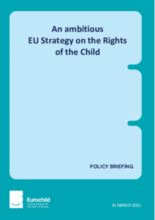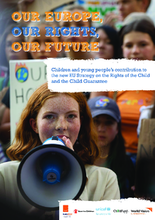Displaying 71 - 80 of 1727
The article discusses two previously published articles by the author and two co‐authors, where the topics are the history of leaving care support in Norway and how the Nordic welfare model may represent a problematic frame for leaving care support.
This paper explores the history of the rights movement of young people in care in England between 1973 and 2011.
The aim of this paper is to examine how a strengths-based approach facilitates working relationships between child welfare services and families.
This is a preliminary analysis of the new EU Strategy on the Rights of the Child was carried out by the Eurochild Secretariat.
This strategy’s overarching ambition is to build the best possible life for children in the European Union and across the globe.
This study explores the recent adaptation of foster care (Koruyucu Aile) in Turkey.
In the present general comment, the Committee on the Rights of the Child explains how States parties should implement the Convention on the Rights of the Child in relation to the digital environment and provides guidance on relevant legislative, policy and other measures to ensure full compliance with their obligations under the Convention and the Optional Protocols thereto in the light of the opportunities, risks and challenges in promoting, respecting, protecting and fulfilling all children’s rights in the digital environment.
This report explores how gender-restrictive groups are using child protection rhetoric to manufacture moral panic and mobilize against human rights, and how this strengthens the illiberal politics currently undermining democracies.
The perspectives and priorities of more than 10,000 children and young people, from within and outside the European Union (EU), are expressed powerfully throughout this report.
This article summarizes the causes of racial disproportionality, arguing that internal and external causes of disproportional involvement originate from a common underlying factor: structural and institutional racism that is both within child welfare systems and part of society at large.







